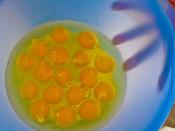Ruth Frenkel MIC 220 Challenge questions set #2 Due April 3, 2002 SID# 601-50-5380 1.2. There are a multitude of reasons that the Escherichia coli did not produce the interferon after being transformed. First, the E. coli cells might not have accepted the plasmid during the transformation process. If the electroporation was used, the voltage might have been too high and irreversibly damaged the cell membrane, thereby rendering the cells incompetent. Conversely, the voltage used might have been too low and not have induced micropores in the cell membrane large enough for the uptake of foreign DNA. For E. coli the voltage range for successful transformation by electroporation is 250 to 4,000 V/cm. Voltages above or below this range will not result in transformed cells, and thus will not express interferon.
Another explanation for the lack of interferon production is that the plasmid did not contain a strong promoter upstream of the inserted interferon gene.
Without a strong promoter, the E. coli's RNA polymerase will not bind to the recombinant plasmid and thus will not transcribe the interferon gene. On the other hand, if there was a strong promoter, the protein could have been over-transcribed and the host cells machinery would be overloaded, resulting in inadequate expression of the interferon.
Yet another reason for the absence of interferon expression is that the inserted gene fragment did not have a leader sequence, also known as a signal peptide. These sequences are typically located at the N-terminus of a protein and facilitate the transport of expressed proteins into the periplasm. This exportation renders the expressed foreign protein more stable than if it remains in the E. coli's cytoplasm. If the interferon gene was not attached to a signal peptide, then it may have been degraded in the cytoplasm by endogenous exonucleases.
Also, since interferon is a eukaryotic protein, its pre-mRNA sequence will contain introns that need to be excised before proper translation into the protein occurs. Since E. coli is a prokaryote, it does not possess the necessary machinery, the spliceosome, to splice out the introns and then translate the mRNA sequence into the protein. If the introns are not excised, the resultant protein will not be interferon but rather a nonsense peptide of unknown function. One way to circumvent this aberration is to synthesize cDNA from already processed mRNA in the laboratory before inserting the sequence into the plasmid. This ensures that only the coding regions of the gene are being transcribed and will be translated into the correct amino acid sequence.
Another reason could be that the growth temperature for the bacterial culture was not optimal, thus inhibiting growth of the E. coli cells and not allowing for the expression of exogenous proteins. E. coli's optimal temperature range is between 28 C and 40 C, with optimal growth achieved at 37 C. Any temperature above this range will denature essential proteins necessary for reproduction and expression of foreign DNA. Additionally, the culture medium used might not have contained adequate concentrations of the specific nutrients needed for E. coli growth. For E. coli to reproduce by binary fission, the culture medium needs to contain ions (Na+, K+, Ca2+. NH4+, Cl-, HPO42-, and SO42-), trace elements, and a carbon source such as glucose. The absence of any of these factors will prevent bacterial growth and thus expression of the interferon.
Any or all of the aforementioned hypotheses could explain the lack of interferon production. When expressing foreign DNA in any bacterial host cell, there are many things that can go wrong and thus careful care must be taken at each step in the process to ensure adequate expression of the proper peptide.
1.1 Competence, in a microbial context, is defined as a cells ability to uptake DNA and be transformed. Many genera and species of bacteria are naturally capable of transformation due to having a period of natural "competence" in their life cycle. Some bacteria contain plasmids that are genetically equipped to form cell-to-cell junctions through which the plasmid DNA is transferred from one cell to another. From an evolutionary perspective, this exchange of genetic information has both its advantages and disadvantages. One benefit of this interchanging of DNA is the acquisition of certain traits that increase the bacteria's rate of survival. For example, if one strain of bacteria were able to grow in the absence of a nutrient that was not readily available, it could transfer the gene responsible for this ability to another strain of bacteria that did not possess this capacity. The second strain would now be able to survive in the absence of the previously essential nutrient, thus increasing its chances of survival in the environment. This mechanism of sharing genes can give rise to genetically superior species of bacteria, enabling them to outcompete genetically disadvantaged species in a Darwinian "survival of the fittest" sense. Some other evolutionary advantageous traits that could be transferred between species of bacteria are resistance to antibiotics, stronger promoters for higher levels of essential protein production and growth, and resilience to extreme temperatures to name just a few.
While the ability of bacteria to exchange genetic information has many benefit, it is not without its drawbacks. For instance, a bacterium that is sensitive to antibiotics could transfer this sensitivity to another strain of bacterium, thereby decreasing its chances of survival if it came into contact with another bacterium that produced that particular antibiotic. Also, during a conjugation event between cells, the new DNA may be incorporated into the bacterium's genome in such a way that it interrupts another gene. If this interrupted gene was part of an essential cellular process, such as recognition by RNA polymerase of a promoter, then the cell would be unable to reproduce or survive for very long. Also, if a newly incorporated gene encodes a protein that is essential in the donor species of bacteria, but toxic to the recipient bacterium, the transformed bacteria will die once expression of this gene occurs. As is apparent by the reasons stated above, the evolution of bacteria was a rather "hit or miss" process, taking millions of years to arrive at the species who were able to survive and that we encounter today.
2.1. The extreme halophiles or halobacteria are aerobic chemoheterotrophs with respiratory metabolism that exist in environments with extremely high NaCl concentrations. The most commonly studied member of the family is Halobacterium salinarium. It is unusual in that it can trap light energy photosynthetically without the presence of chlorophyll. This mechanism is advantageous to Halobacterium because oxygen is not very soluble in concentrated salt solutions and may decrease to an extremely low level in its habitat. This inhibits aerobic respiration in the bacteria. Their way of compensating is through the unique photosynthetic system. Under conditions of low oxygen and high light intensity, the bacteria synthesize a deep-purple pigment called bacteriorhodopsin, which functions as a light driven proton pump. When the pigment absorbs light, it undergoes several conformational changes that are involved in proton transport. The light-driven proton pumping generates a pH gradient that can be used to power the synthesis of ATP by a chemiosmotic mechanism. Halobacterium developed this photosynthetic system as a coping response to the occasional lack of oxygen in their high salt environment, thus enabling them to survive the stress of temporary oxygen limitation by means of photosynthesis to produce energy.
Another extremophile is the extreme thermophilic bacterium, of which some species are capable of withstanding environmental temperatures over the boiling point of 100 C. These organisms thrive in many habitats including composts, self-heating haystacks, hot water lines, and hot springs. In order to withstand these extreme temperatures, the thermophiles have developed much more heat-stable enzymes and protein synthesis systems able to function at high temperatures. Their proteins have many disulfide bonds which increase their thermostability, or ability to remain active under high temperatures. Their membrane lipids are also very saturated fatty acids and thus have much higher melting points than other types of bacteria so the membrane is able to remain intact at very high temperatures. Also, the ability to metabolize and use sulfur as an energy source is beneficial to the thermophile because sulfur is often readily available in extreme environments, such as the Sulfolobus inhabiting the hot sulfur springs of Yellowstone National Park. These bacteria obtain their energy by oxidizing elemental sulfur to sulfuric acid at a temperature between 70 - 75 C.
2.4 Within the context of microbiology, I would suggest that part of the money from the Bill and Melinda Gates foundation be used to fund research involving microbial degradation of xenobiotics. The most common methods of hazardous waste disposal are incineration and chemical treatment to break down to toxic chemicals, but these methods are costly and often create new environmental problems. The discovery in the 1960s that some microorganisms are naturally capable of degrading xenobiotics has given rise to the notion that microbial degradation might provide an economic and effective means of disposing of toxic chemical wastes.
Members of the genus Pseudomonas are the most predominant group of microorganisms that degrade xenobiotic compounds. Certain strains of this genus can detoxify more than 100 different organic compounds. Degradative bacteria possess certain enzymes and biochemical pathways that can convert xenobiotic, nonhalogenated aromatic compounds to either catechol or protocatechuate. Then, through a series of oxidative cleavage reactions, catechol and protocatechuate are processed to yield either acetyl coenzyme A and succinate or pyruvate and acetaldehyde. These final products are compounds that are easily degraded by almost all organisms. One drawback of bioremediation is that the microbial strains cannot break down all classes of xenobiotics. One way to address this problem is to transfer by conjugation into a recipient strain a plasmid that carries genes for different degradative pathways. Thus, one bacterial strain can possess the ability to break down a wider range of xenobiotic compounds. I believe that funding this area of research will prove to be a wise investment for the Gates Foundation, as microbial degradation stands to help alleviate and possibly eliminate the problem of toxic pollution in our environment in a safe manner.
Another promising area of research that could benefit from part of the 1.3 billion dollars is the construction of attenuated retroviral vectors for use in gene therapy. Gene therapy may help ameliorate some human genetic diseases in the future. The essentials of gene therapy are the delivery of a remedial gene and its expression in a cell type or tissue that cures a disease without risk to either those administering the therapeutic agent or those receiving it. Most of the previous attempts at human gene therapy have involved using vectors derived from human viruses because they have specialized delivery mechanisms for entering specific cells. Retroviral vectors were considered the most promising, but the native form of retroviruses can cause cell damage or even cancer in some cases. Then in 1983, Mann et al. Constructed the first retroviral packaging cell line, in which they integrated a viral genome from which they had removed a DNA segment that contained the packaging signal into a chromosome of a cell line. Under these conditions, the cell line is able to produce non-infectious virus particles. After transfection of these new cells with a DNA construct that has a packaging signal and a remedial gene but no retroviral gene, the construct is packaged into virus particles that can be used to deliver a remedial gene to a particular cell type. This concept and technique has tremendous potential in the field of human molecular genetics. Many genetic diseases, such as Cystic Fibrosis and Spinal Muscular Atrophy, could potentially be cured or their symptoms alleviated with the delivery of a copy of the remedial gene to the patient using this novel retroviral packaging vector. Funding of this research would be greatly beneficial to the human population afflicted with autosomal recessive diseases.


